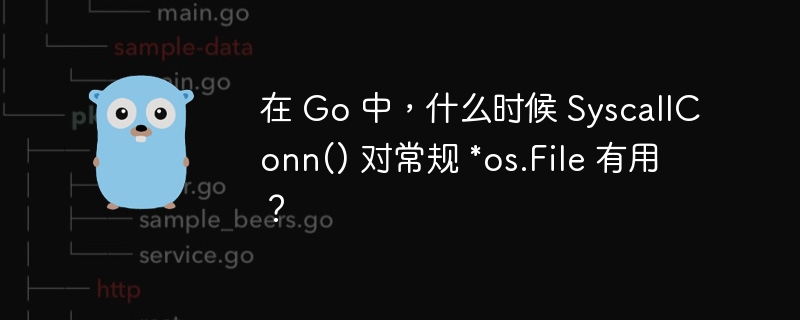Home >Backend Development >Golang >In Go, when is SyscallConn() useful for regular *os.File?
In Go, when is SyscallConn() useful for regular *os.File?
- 王林forward
- 2024-02-05 23:30:03943browse

I am reading some instructions on using SyscallConn() (on *os.File defined function) Go code (from https://github.com/KarpelesLab/reflink):
// reflinkInternal performs the actual reflink action without worrying about fallback
func reflinkInternal(d, s *os.File) error {
ss, err := s.SyscallConn()
if err != nil {
return err
}
sd, err := d.SyscallConn()
if err != nil {
return err
}
var err2, err3 error
err = sd.Control(func(dfd uintptr) {
err2 = ss.Control(func(sfd uintptr) {
// int ioctl(int dest_fd, FICLONE, int src_fd);
err3 = unix.IoctlFileClone(int(dfd), int(sfd))
})
})
if err != nil {
// sd.Control failed
return err
}
if err2 != nil {
// ss.Control failed
return err2
}
if err3 != nil && errors.Is(err3, unix.ENOTSUP) {
return ErrReflinkFailed
}
// err3 is ioctl() response
return err3
}
In this example, use these Control() functions instead of directly using d.Fd() and s.Fd() Is there any Advantage? More generally, what is func func (*os.File) SyscallConn() (syscall.RawConn, error) used for?
Correct answer
##file.Fd() Returns a file descriptor, and it causes the file descriptor to run in blocking mode (occupying a thread for blocking operations). SyscallConn does not do this. In fact, it was created specifically to get a file descriptor without blocking it. See this question for more information.
The above is the detailed content of In Go, when is SyscallConn() useful for regular *os.File?. For more information, please follow other related articles on the PHP Chinese website!
Related articles
See more- What's the Best Way to Connect to MySQL from Go?
- How to Create a Singleton DB Instance with Exported Methods in Go?
- Why Am I Getting 'Variable Not Declared' Errors in Go Conditional Statements?
- How Can I Effectively Handle Unstructured JSON with Arbitrary Keys in Go?
- How to Efficiently Get the String Representation of a Go Type?

